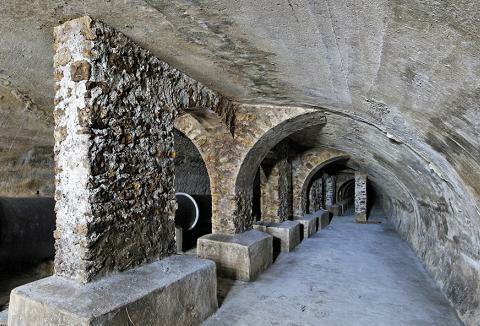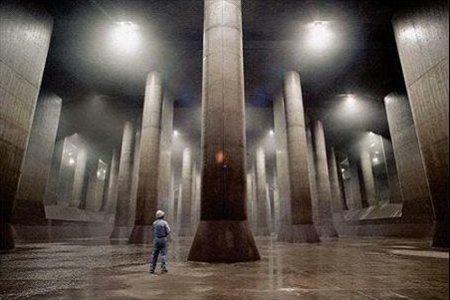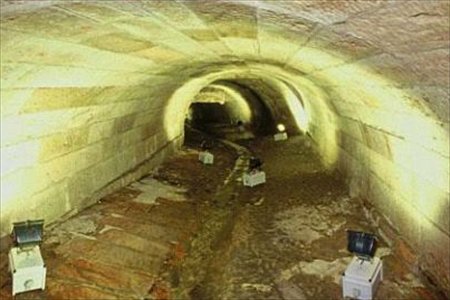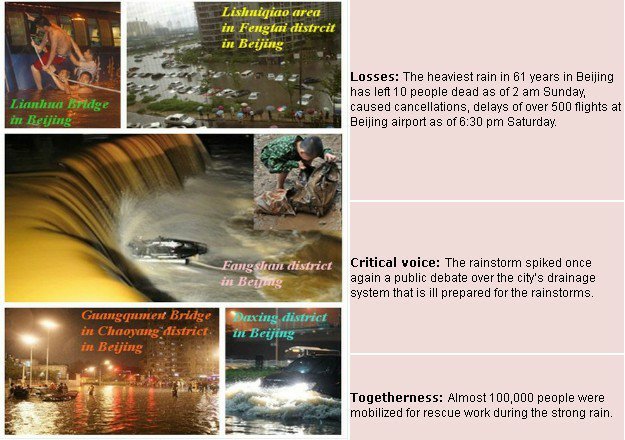HOME >> CHINA
Outdated drainage blamed for flood havoc
Source:Globaltimes.cn Published: 2012-7-23 18:06:00
| Editor's Note |
As a new round of torrential rains continues to batter parts of China, many cities have been suffering from severe flooding, a chronic problem that has exposed flaws in some cities' drainage management.
| Drainage Blamed for the Flood |
Downpour in Beijing
The heaviest rainstorms in 61 years hit the capital over the weekend, resulting in 37 deaths recorded as of 5 pm Sunday, authorities have announced.
A total of 25 people drowned, six were killed by collapsing houses, five by electrocution, and one by lightning strike, the Beijing municipal government said on its Sina Weibo account. Over 1.9 million residents have been affected, officials say.
According to official statistics Sunday, the latest downpour in Beijing has already led to economic losses of nearly 10 billion yuan.
In other cities
On June 26, several hundred people in the city of Shaoguan in South China's Guangdong Province became stranded after some parts of the city were submerged in up to two meters of water.
On May 7, 2010, the rain storm in Guangzhou took six lives and led to economic losses of over 500 million yuan ($78 million).
Firefighters in the city of Hangzhou in East China's Zhejiang Province experienced their "busiest day in history" on June 18, tackling 110 emergencies related to flooding in the city.
| Comments |
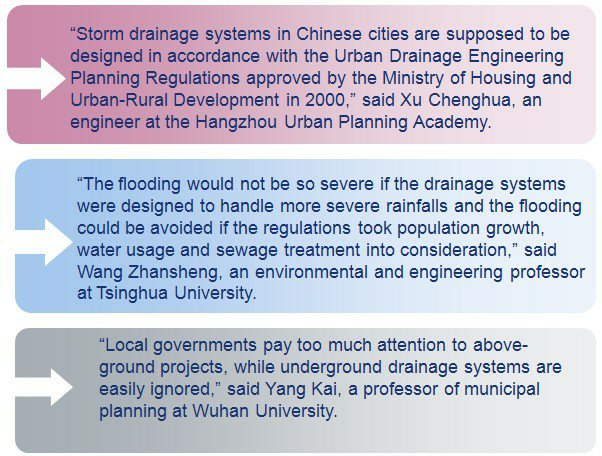

Source: Xinhua
| Good Examples in China |
A The Imperial Museum and Tuancheng in Beijing
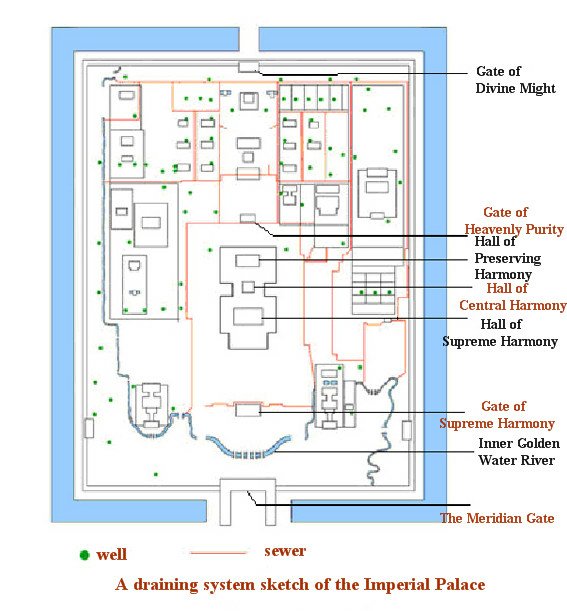
The drainage system in Tuancheng, where there are several ancient buildings, near the Beihai Park in Beijing, was built around 600 years ago but remained in good condition. Various hydrophthalmos were kept near the ancient trees planted in Tuancheng so as to better help rainwater being absorbed by the ground.
Source: The Beijing Times
B Ganzhou, Jiangxi Province
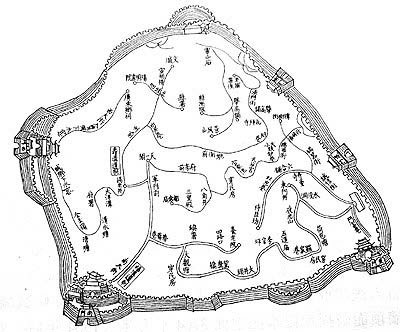
Ancient fushougou draining system in Ganzhou, Jiangxi Province. Photo: Xinhua
The old drainage system in Ganzhou, Jiangxi Province, which was built during the Northern Song Dynasty (960-1127), remained in good service. It helped discharge the water quickly when a round of torrential rain in 2010 swept the city with the precipitation climbing to around 100mm a day.
The drainage system, or fushougou, for its similar shape to the two Chinese characters fu and shou, made good use of the altitude differences of the city to guide the rain and the sewage to the river naturally from high to low areas.
Source: China Youth Daily
C Qingdao, Shandong Province
The drainage system in Qingdao, Shandong Province, established in late 19th century and early 20th century when the city was colonized by Germany, was famous for its design which is able to shunt the flow of rain and sewage.
Besides, the city government also made use of the city’s altitude difference when designing the drainage systems so the water can naturally flow from high altitude areas to low ones, and then to the rivers, according to An Baoyue, the section chief of the city’s drainage management department.
An Baoyue also contributed to the city’s strong drainage system capabilities to the practical and efficient drainage maintenance and flood prevention emergency system.
Source: The 21st Century Business Herald
| Good Overseas Examples |
| Built in 1850s, the ancient Paris sewer system has 26,000 manhole covers, more than 6,000 underground reservoirs, and around 1,300 specialized maintenance professionals. Statistics of the Paris Sewers Museum shows that the whole Parisian sewer tunnel is 2,399 km long. A total of 15,000 cubic meters of solid waste can be recycled from waste water per year. Right now, Pairs has four sewage treatment plants which can purify over 3 million cubic meters of waste water per day, and all of the purified water drains off into Seine. A total of 400,000 cubic meters of waste water which used to flush the Pairs streets and water the flowers all come from Seine. More than 15,000 cubic meters of the city’s sewage were discharged through the ancient sewer system every day. |
|
| Tokyo’s underground drainage system was built for preventing typhoon and rainstorm disasters. The system, rated as the world's most advanced one, went to operation in 1992 and finished in 2006. The system is built so that it can discharge the heaviest rainfall in five to ten years. In comparison, Beijing’s system can only drain the heaviest downpour in one to three years. The maximum diameter of a drainage tunnel of the system, built with a series of concrete pits, is about 12 meters. |
|
| Built 2,500 years ago, ancient Roma’s underground drainage system still works in modern-day Rome. |
Source: Xinhua
| Related Reports |
Posted in: Society
